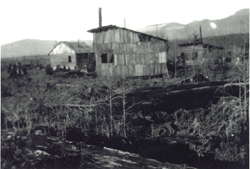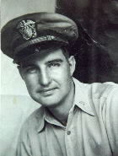The Stump Ranchof the Upper Skagit Valley John Wesley Savage 1889-1971 |

|
The Stump Ranchof the Upper Skagit Valley John Wesley Savage 1889-1971 |

|
Life & Legend of John W. Savage

|
When winter came, the hills were white and that meant, "tracking" snow.By the following spring John was still extremely weak and slow to heal, Kate goes on to tell in a following poem that John was sent to shelter in a cabin to get some mountain air and gain his strength. This seemed to do the trick, plus he got to regale his friends who came to visit him with his adventure at the same time. Kate ends her poem with…
And brother said to me one night, "I think to hunt I'll go."
We had no ammunition, so we went down to the mill.
"We'll find some lead," my brother said, "And then some shells we'll fill."
Our search brought on Babbitt. We never did find lead.
Said he, "I know this stuff will melt. We'll just use it instead."
We took it home and "het" the spoon. We poured it in the molds.
The blanks were powdered very soon. The caps shoved in the holes.
John grabbed the old gun from the wall and boasted, "Here I go!"
He looked so very grand and tall while striding through the snow.
But brother shot himself that day with that old blunder gun,
And bleeding in the snow he lay, a sad end to his fun.
He weakly staggered home at last. Pa got him to a boat.
Then tried to row so very fast amid drift ice afloat.
Pa aimed to reach the nearest town to get a doctor's care.
He raced the Skagit River down with his helpless burden there.
It was no use. The darkness fell and brother dying lay.
Pa was mighty tired as well with town still far away.
Then on the riverbank he saw a tiny twinkling light.
It pierced the fog, now cold and raw, a beacon in the night.
The farmer took a horse and sped to get the doctor quick.
And still alive but badly spent my brother lay so sick.
The doctor came and all was well. No lead poisoning was there.
That alloy bullet, sharp and clean, had saved him by a hair.
Said Pa, "Since you two had to snoop, I'm glad you found hard metal.
Had it been lead, he would be dead. But now he's in fine fettle."
Sighed brother as in bed he lay, "I want to get my deer.
Though I'm no hunter as you say. I'll try my luck next year."

ObituaryFuneral services fro John W. Savage, 84, of 1911 N.W. Sloop Pl., a World War I veteran and painter, will be at 3:00 p.m. Tomorrow at Wiggen & Sons. Burial will be in Acacia. He died Monday.A native of Birdsview, Skagit Co., Mr. Savage painted logging activities on the Skagit River as he remembered them from the 1870's. The paintings were published in The Times Charmed Land Magazine. The Washington State Historical Society purchased the originals. Mr. Savage was a house painter as a youth when he lived in Hamilton, on the Skagit River. He later began sign painting. He painted an eight-story-high sign on the upper portion of the Roosevelt Hotel. Mr. Savage and C. E. Stevens painted signs in this state, Idaho, North Dakota and Montana. In one year they painted 1,800 Fisher's flour signs. Mr. Savage retired from sign painting in 1937. Mr. Savage worked for the Navy in Bremerton until 1941 when he retired again. He was a member of the Military Order of the Purple Heart, the Disabled American Veterans of Foreign Wars and the 91st Infantry Division. He was a charter member of the Salmon Bay Aerie No. 2141, Eagles, and an honorary member of the Washington State Historical Society. Surviving are two sons, Theodore, Seattle, and Dr. Bob Savage, Langley, Whidbey Island, and two sisters, Mrs. Rose Brobock, Anacortes, and Mrs. Catherine Pulsipher, Birdsview. return to top of page The Savage Homestead, Birdsview; in the family since 1878
 |

 This kind of art was extremely repetitious. In one year Steven and Savage painted 1,800 Fisher's flour sign. The first season on the road was a good initiation. Part of a mill contract called for painting 96 signs across the tops of grain elevators. The metal was so hot to paint in summer it almost burned the men's fingers. In winter they worked in snow so deep they could not drive the car.
This kind of art was extremely repetitious. In one year Steven and Savage painted 1,800 Fisher's flour sign. The first season on the road was a good initiation. Part of a mill contract called for painting 96 signs across the tops of grain elevators. The metal was so hot to paint in summer it almost burned the men's fingers. In winter they worked in snow so deep they could not drive the car. Savage made the acquaintance of his wife [Nellie Wallace] when he was painting in Spokane. On a wintry morning a girl in a white apron hurried past him on the street as he was headed for a restaurant. Concluding that she must be a waitress, he followed her half a block and into the Golden West Café. He was so smitten that he proposed before leaving town. She accepted and joined him in Chehalis, where they were married.
Savage made the acquaintance of his wife [Nellie Wallace] when he was painting in Spokane. On a wintry morning a girl in a white apron hurried past him on the street as he was headed for a restaurant. Concluding that she must be a waitress, he followed her half a block and into the Golden West Café. He was so smitten that he proposed before leaving town. She accepted and joined him in Chehalis, where they were married.|
The Stump Ranch ® The Stump Ranch On-Line Magazine ® Dan Royal, Editor & Webmaster 38090 Kelly Ln. Concrete, Wa. 98237 360-826-6141 Mission Statement and acknowledgments |
|
 |
|
|
|
|
|
 View My Guestbook Sign My Guestbook |